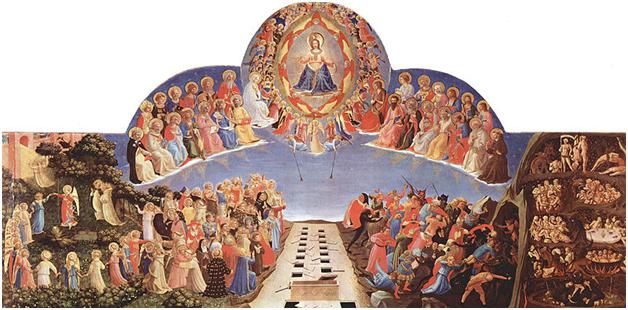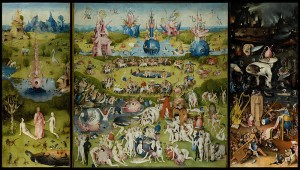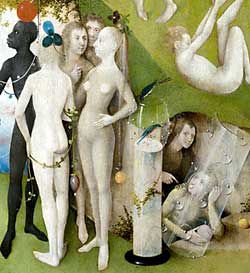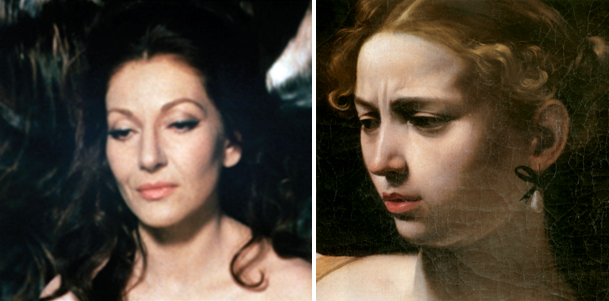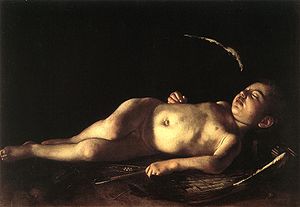The Christian Church of the Middle Ages was the most important institution of the time, holding an unyielding power over what the general population thought and believed. More often than not, art of the period venerates Jesus in all of His glory, placing him at the centre on a throne, judging who shall pass through the gates of Heaven and who will be banished to eternal damnation. These images gave strength to the many believers while terrifying some skeptics towards belief.
Take Fra Angelico’s The Last Judgement (1425-1430) for example. Christ sits in judgement on a white throne surrounded by John, Mary, the saints, and angels, his right hand pointing towards Heaven, while his left indicates Hell. On his right is paradise, a beautiful garden leading to a city on a hill; angels lead the saved to meet their loved ones. To Christ’s left, we see demons forcing the damned back into Hell to take their place for eternal torment. At the very bottom, Satan gets his fill of three sinners while two others wait in his grips.
Once considered terrifying, today these images are subjects of ridicule and disbelief. The length to which believers went to assure their salvation in a place that will more likely than not turn out to be imaginary and intended to ease the fear of death, is simply laughable. Do you believe in God the Almighty and His Son that died for your sins? Should we, in fact, sin more in order to be sure that He died for the right reasons?
See more religiously charged images in Heaven, Hell, and Dying Well: Images of Death in the Middle Ages at The J. Paul Getty Museum, exhibiting until the 12th August 2012. Furthermore, bring these images home with Art of the Devil, a high-quality art ebook full of detailed images of life after death, stemming from the artists’ deepest fears.
Little is known about Hieronymus Bosch. A Dutch painter born in the 15th century, the most we know about him is gleaned from the mere 25 paintings that are definitively attributed to him (a number significantly whittled down over the years).
Using triptychs and diptychs, Bosch was able to conduct religious narratives through his art. Among his most famous is The Garden of Earthly Delights (c. 1480-1505) – was Bosch really as stern a Christian as demonstrated in this painting?
At first glance, you’d be forgiven for thinking the scene is a whimsical child’s fairytale. But closer inspection reveals the heavenly and hellish intricate details, embodying both ecstasy and despair.
To me, this is a warning from Bosch’s moral high horse. The story of the Fall of Man. On the left panel (the start of the story), God is bringing together Adam and Eve in the Garden of Eden. The large middle piece shows an orgy of indulgence – humanity acting with free will, engaging in ultimate indulgence. The right reveals the misery of the depths of hell – the consequences of man’s sin: God’s awesome wrath (prompted of course at the start, by Evil Eve).
Some scholars disagree that Bosch was a religious zealot, claiming instead that the tender colours he uses and the beauty of the scene means he can’t possibly have deemed them as sinners. More controversially, it has even been pointed out that his use of ‘hairy’ figures (figures coated in a layer of brown fur) in the middle panel could be indicative of his heretical view of evolution. Some art historians argue they are simply an imagined alternative to our civilised life. What do you think?
Explore the mysteries of Bosch along with other artists at the Tracing Bosch and Bruegel. Four Paintings Magnified exhibition, showing at the National Gallery of Denmark in Copenhagen until 21st October 2012. If you can’t make the exhibition, but want some more information about Bosch and his art, find all you want and more in this lavishly-illustrated Bosch ebook.
Significant troublemakers of their time, Italian film director Pier Paolo Pasolini is frequently likened to Italian painter Caravaggio, both personally and professionally. Why and how are the artists so similar?
Caravaggio’s fine art is accredited with the invention of cinematic lighting – the dramatic contrast of dark and light, the minute detail of the human figure and the intimate reveal of every quirk and blemish feature in all of his pieces. His work is surely the closest we can get looking at a photograph of the 16th century. Pasolini, equally misunderstood in his lifetime because of his extreme political views, produced some of the most shocking films of the 20th century.
Revolutionary, homosexual and willing to cause a stir, the eerie likeness of their backgrounds (which both remain matters of conjecture) perhaps influenced the similarly dark, stark direction of their work, which typically oozed with as much disdain as it did provocation.
While comparisons between fine art and film can be ambiguous, the dramatic lighting both artists regularly adopted is an undeniable common denominator, as can be seen in a screenshot of Pasolini’s film Teorema (1968), left, and Caravaggio’s masterpiece Judith and Holofernes (1597 – 1600), right:
Caravaggio and Pasolini tended to enjoy the company of the outcasts of society, who they used as models for their work. Unlike his contemporaries, Caravaggio often used ‘common’ people as historic, religious, and wealthy figures, such as Sleeping Cupid (1608), in which a sleeping child is depicted as Cupid (below). Pasolini, similarly, embraced the poor and honest characters from rural Italy, often choosing to use country dialects in his films, rather than mainstream Italian language:
The techniques employed by Pasolini and Caravaggio shed light on a darker side of humanity, one that is real, graphic and well out of range of the popular culture of their times. The artists, three hundred years apart, have evidently reached a mutual understanding of the human condition.
As the exquisite Picasso and Modern British Art exhibition rages on in style at the Tate Britain, Parkstone International is delighted to present a lifelong souvenir of the event – Picasso, the ebook.
Similar to the exhibition itself, this convenient and excellent-quality title allows readers to take full advantage of Picasso’s glorious artwork, in a convenient digital format, allowing you to pop into Picasso’s gallery of masterpieces whenever you choose, and as many times as you’d like.
Pablo Picasso is among the most famous figures in 20th-century art, whose works serve as testament to the parallelism of his life and art, underlining the impact of important encounters and events. Tate Britain’s exhibition emphasizes Picasso’s influence of modern art in Britain, also featuring seven of “Picasso’s most brilliant British admirers”. Should you like to learn more about the exhibition, visit Tate Britain’s website for more information
If you love art as much as you love books, this title will be an indispensable addition to your digital collection.
By Category
Recent News
- 04/03/2018 - Alles, was du dir vorstellen kannst, ist real
- 04/03/2018 - Tout ce qui peut être imaginé est réel
- 04/03/2018 - Everything you can imagine is real
- 04/02/2018 - Als deutsche Soldaten in mein Atelier kamen und mir meine Bilder von Guernica ansahen, fragten sie: ‘Hast du das gemacht?’. Und ich würde sagen: ‘Nein, hast du’.
- 04/02/2018 - Quand les soldats allemands venaient dans mon studio et regardaient mes photos de Guernica, ils me demandaient: ‘As-tu fait ça?’. Et je dirais: “Non, vous l’avez fait.”

